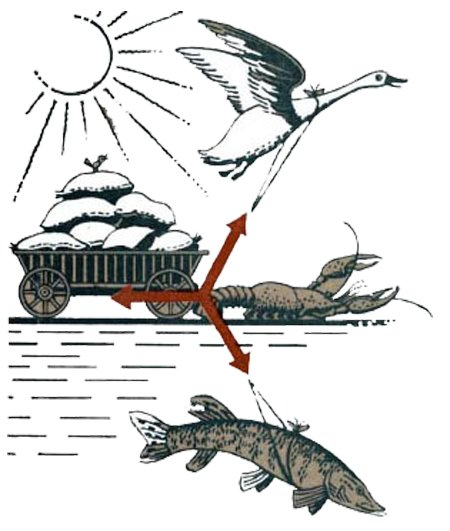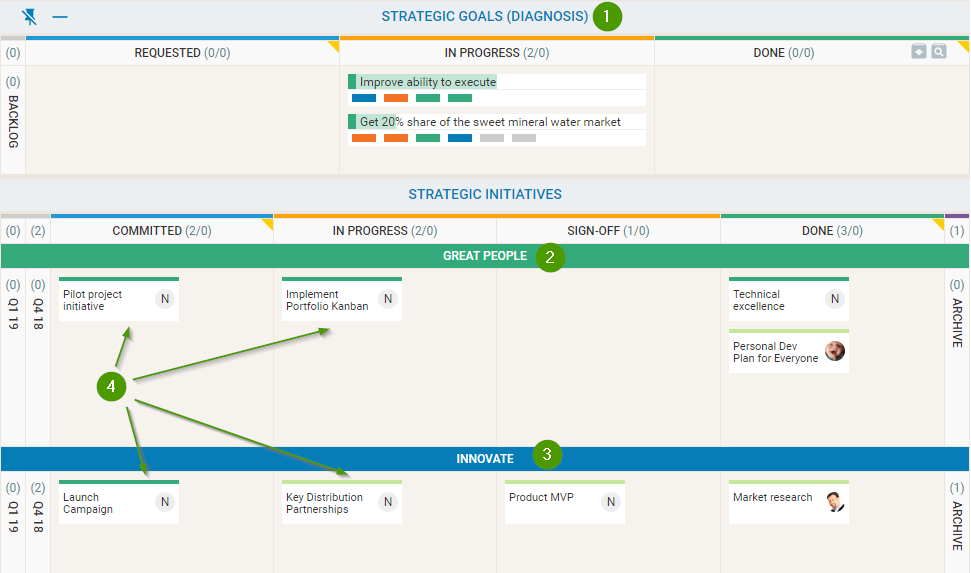As a CEO, a major part of my work is to define the strategy of the company and follow through on execution. Sounds easy, but it's the most challenging job I've ever had. It takes enormous amounts of energy, military discipline, and courage.
If you think I'm fooling you, just let that sink in: 90% of strategies fail!
Studies show that as much as 90% of all change initiatives and strategies fail, due to the lack of proper follow through on execution. It boggles my mind how much money is being spent and lost on stuff that never happens. It also brings painful memories - I've done that, I've been there.
In the very beginning of Businessmap (formerly Kanbanize), we didn't really have a clear strategy. We were completely focused on building the MVP and closing our first deals. It took us a few years to make it all work and, quite frankly, we were a very successful small team.
Then, life happened.
When we started the company, I thought that crossing the 1 million line would magically make things easier. We landed this mark fairly quickly, but instead of champagne and chocolate, this milestone only gave us the painful realization that turning a start-up into a real business requires 10x the energy.
Offtopic: Isn't this yet another example that finishing stuff is harder than starting it?
Hitting 200% growth year over year in our start-up years made the drop to 30% growth later on extremely painful. Some would say that 30% growth year over year is good, but we were all miserable because of it. I was questioning my ability to lead the company, and at times I thought I should pass the management to a professional CEO.
Luckily for me, I had amazing people on the board to learn from. They gave me a hand and helped me become that professional CEO. But don't you dare think they were the nice guys who let me cry on their shoulder when things went wrong. Quite the opposite.
They had all these crazy questions "What's your strategy?", "How do you forecast your budget?", "What initiatives have you planned for next year?" and so on. Being a first-time CEO, I had no clear answer to all these questions, and that made me feel even worse. Then it clicked...
Of all the questions I was getting, the most consistent one was "What's your strategy?". This is a deceivingly simple question, and I never paid much attention to the clear definition of strategy. But I somehow realized this was the key to unlocking the future growth of the company.
That's how I started reading about strategy a lot. I must have found and digested every good book on strategy out there. However, the top belongs to Richard Rumelt and his Good Strategy Bad Strategy.
This book and many trials and errors helped us get the growth of the company back on track. Throughout the rest of this article, I'll be sharing why exactly it worked.
The Strategy Kernel
Mr. Rumelt talks about the Strategy Kernel. He says that a good strategy must have these three components:
- Diagnosis
- Guiding Policies
- Coherent Actions
Diagnosis
This is the analysis of a given challenge or opportunity. A sample diagnosis could be "growth is hindered due to tight competition" or "There's an untapped market potential for sweet mineral water". The diagnosis is the start of the strategy thinking process.
Guiding Policies
The guiding policies are a bit abstract but a very important term. It aims to channel actions in a given direction without telling exactly what has to be done. An example guiding policy could be "Focus on existing customers first, then on new sales" or "Spend 15% of your time on self-development". Guiding policies are like a holy book - they get people to do good without going into the specifics of everyday life.
Coherent Actions
As strange as it may sound, action is what is often missing in the strategy of huge, successful companies. At least that's what Mr. Rumelt says. He claims that bad strategy is by far the norm and you only find good strategy once in a while. More often than not, the root cause for bad strategy is the lack of coherent actions that get you closer to your goals.
Coherent actions are what you actually do to make things happen. Please don't overlook the word coherent. If your sales department is trying to increase the expansion revenue, but your product team is building a new product, your sales team is likely going to fail.

There's a very nice Bulgarian fable about the bird, the lobster, and the fish. They were tied to a wheelbarrow that had to be pulled from point A to point B. They all tried really hard, but because each one was pulling in a different direction, they never got the job done. Simply put, their actions were not coherent.
The Portfolio Kanban Strategy
I've been lucky enough a few times in my life when I was able to connect the dots between different concepts to create a new idea ultimately. My struggle with strategy took place at the same time when we were conceptualizing and, to an extent pioneering the Portfolio Kanban method*.
*I'm not claiming that Businessmap as a company has invented this method, I'm rather saying that we are one of the most dedicated proponents, and we work hard to popularize it.
This coincidence led to the realization that Kanban and the Strategy Kernel fit very well together. Not only that, but it actually gives you the benefit of tying your strategic actions to real execution (I'm assuming the use of the Businessmap software platform Kanbanize). So what I'm saying is basically the following:
- You can visualize your entire strategy at a single Kanban board.
- You can see what is being worked on, what has been done and what is blocked in real-time.
- If you use software like Kanbanize, you can break down the strategic actions into smaller work items for your teams to work on, which will fill the gap between strategy and execution. Remember that this was where 90% of the CEOs fail.
That's how it looks like with sample data:

At the top, there's a portfolio lane (1) where the diagnosis is represented by actual goals. In the example above the two goals are:
- Improve ability to execute
- Get 20% market share for sweet mineral water
Then we have the guiding policies (2) and (3) that are represented by horizontal swimlanes on the Kanban board. In the current example, there are two guiding policies:
- Great people
- Innovate
Finally, come the strategic actions (4) that are represented by Kanban cards on the board. You can see what the actual actions are in the cards, but one thing is very important.
The actions (4) are actually linked to the goals (1) as children cards in the system. This allows a specific action to attribute to a concrete goal while at the same time comply with the guiding policy (the swimlane where the card is). This one-to-many relation is crucial for the actual implementation of the strategy.
The Benefits
It took me years to get to this solution, which I believe is a game changer, but I'll get it if you're thinking, "What was that about?". Let me point out why this representation of the Strategy Kernel on a Portfolio Kanban board means so much to me.
Focus via Simplicity
This single view allows you to focus the entire organization on the concrete goals that have to be achieved using a very simple Kanban board. It takes a few minutes to explain a digital screen to transmit the message and a regular feedback loop to check on the progress. Nothing more, nothing less.
In their book "Made to Stick" Chip and Dan Heath dissect why some ideas fail and some succeed. One of the key characteristics of the successful ones is simplicity. We all know this big, heavy enterprise system that allows us to plan everything in advance. But do people actually use it?
Transparency
Believe it or not, most executives don't know what their teams are working on. Should they even bother? Sometimes yes, sometimes no. However, you sometimes need to make sure people are working on the right thing and help them re-adjust if needed.
Using this approach, I can instantly see where work is. Is it blocked? Is it going okay? Should I be worried? Is my strategy working at all? We're getting all the things done, but do they lead to the outcome we want? These are all questions I can answer myself in a few minutes thanks to the first practice in Kanban - visualization.
True Representation of Capacity
Nothing is as big of an eye-opener as this approach to strategy. The minute you visualize all the actions on your strategic board, you will realize you're spreading yourself too thin. I bet you're working on too many things at the same time and you don't even know.
When you put it all on the canvas, you get an instant feeling of how much exactly you've put on the table and how much you can actually handle. That is, you start seeing your organization's capacity in a non-distorted way.
If you've heard about Kanban, you must have seen the huge opportunity to limit work in progress at the highest level in the organization possible. If you do that, chances are that no team in the company will suffer from overburdening and will be much faster to meet customer demand.
Follow Through
When you've committed to deliver on X, and that X is visible on the board, you can't just bury it in a spreadsheet. You're forced to follow through, even when it's really hard. This follow-through is the real game changer. It doesn't let you bail out on things that easily.
It's like marriage. You don't simply dump your partner for whatever reason. Because of your commitment to one another, you work out the issues. Yeah, things can go wrong, and there are ways to deal with that, but nobody walks away from their spouse easily. That's a core idea in Kanban - whatever gets started has to be finished in order to improve flow.
Conclusion
Strategic thinking and Kanban can go hand in hand and complement each other. Your strategy answers the question "What?" while Kanban answers the questions "When?" and "How?".
The visual and flow-based nature of Kanban helps executives map their existing strategic initiatives and obtain a clear picture of the available capacity.
Being able to optimize WIP limits at such a high level in the hierarchy helps prevent overburdening and speeds up delivery across the whole company.
The Kanban board serves as a bounding mechanism that forces executives to follow through on the existing strategy and evolve it, if necessary.

Dimitar Karaivanov
CEO and Co-founder of Businessmap
Dimitar is a lean thinker and a Kanban practitioner with a solid background in the areas of software development and process improvement. He is passionate about achieving extreme performance at scale and applying Lean/Agile principles outside IT.



